Tag Archive: resources
January 10, 2014
by Robin Parker -
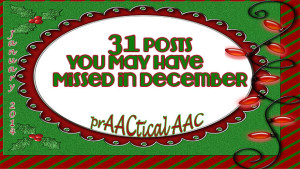
STRATEGY OF THE MONTH Supporting Pre-Intentional Communicators Breaking Through with Pre-Intentional & Beginning Communicators of ALL Ages Helping Pre-Intentional Communicators to Cross the Intentionality Bridge More Ideas for Supporting Pre-Intentional Communicators PRAACTICAL THINKING PrAActical Nominations: The 2013 Edublog Awards I was Thinking About Buying an AAC App- Now What? 5 Ways to Encourage AAC Learners 30 P0sts You May Have Missed in November How Much Time Do SLP’s In Healthcare Settings Spend on AAC Services to Children AAC Goes to the Eddies Does AAC Benefit Children with Profound and Multiple Disabilities Throwback Thursday: Talk About Me 2 3 Responses to Programs that Make Kids ‘Prove Worthiness’ Prior ro Providing Access to AAC AAC Vocabulary Lists Throwback Thursday- Past Posts About Pre-Intentional and Beginning Communicators Power Words from PrAACtical Friends A PrAACtical Christmas Carol 8 Ways to Have an AAC Holiday Season A PrAACtical Christmas AACtual Therapy with Shareka Bentham- Started from... [Read More...]
Filed under: PrAACtical Thinking
Tagged With: Intentional Communicators, Pre-Intentional Communicators, resources
December 5, 2013
by Robin Parker -

Strategy of the Month Thoughts on Teaching Core Vocabulary Teaching Core Vocabulary with Direct Instruction Strategies New Word Teaching: A Look Inside Some PrAACtical Therapy Sessions Core Words, Direct Vocabulary Instruction, & the Beginning Communicator PrAActical Thinking Fun Friday- 5 Tips for Talking About Halloween After it is Over 31 Posts You May Have Missed in October A PrAACtical Literacy Activity for Beginning Communicators Writing Goals for AAC Learners Fun Friday: Holiday Shopping with a Purpose 10 Apps to Gift to An SLP Hockey Lessons Watch it Wednesday: Using Routines to Promote Interactions by the Watson Institute Throwback Thursday: Say This, Not That to Reinforce Vocabulary Learning Fast FAACt Friday: AAC’s 1st Appearance in the Professional Literature How Do You Teach Others to Implement AAC Facilitation Skills? Watch it Wednesday: Time Timers At the Very Beginning: Working with Pre-Intentional Communicators Display Stand for Visual Supports or Books PrAACtical Thoughts on... [Read More...]
Filed under: PrAACtical Thinking
Tagged With: AAC Participation, resources
October 17, 2013
by Robin Parker -
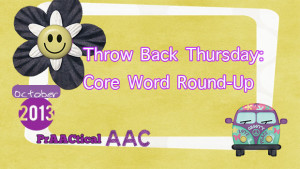
Core Word Round-up! Core Word PrAACtice Ideas Magic Moments: AAC Intervention with Stop and Go App Magic Moments with Toca Store Magic Moments with Sentence Builder Magic Moments with Verb Circus HiJAACked! Putting an AAC Twist on Gen Ed AACtivities: The Hallelujah Flight AAC Goes to PreSchool 5 PrAACtical Uses for Flashcard Apps Visual Language, Core Words, & Martin Luther King Can I Ask You A Question? Breakthroughs with Bubbles with Tanna Neufeld 14 Valentine’s Day Activities, Love, Literacy, & Learning AAC Learning with Play Dough by Jamie Cooley 5 Ways to Use Power Point in AAC Intervention 5 PrAACtical Thoughts on Catch-Up Conversations How I do It- Marlene Cummings Shares an Implementation Toolbox AACtual Theray with Tanna Neufeld- Use Your Best Spud To Teach Vocabulary How I Do It- Marlene Cummings On Strengthening the Communication... [Read More...]
Filed under: PrAACtical Thinking
Tagged With: resources, teaching
October 12, 2013
by Robin Parker -
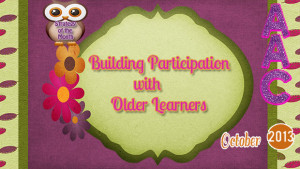
We love active participation for communication and language learning. Actually, we love active participation in all areas of life for us, for our students, for everyone. When Carole introduced the Building Participation Strategy of the Month, she discussed the role of the Participation Model (Beukelman & Mirenda, 1988; 2013). The Participation Model is a framework for understanding the barriers to participation and then from a prAACtical intervention standpoint developing strategies and activities to increase active participation in a variety of (ALL) aspects of life. For the 2012 AAC Awareness Month, we discussed barriers to participation. This year’s focus is on activities and strategies for getting past the barriers to building age appropriate authentic active participation for ALL learners. We have learned that when older learners with significant communication challenges are provided with age appropriate activities and supports, they can be engaged and motivated to participate and can often surprise us with... [Read More...]
Filed under: Strategy of the Month
Tagged With: activities, building participation, older learner, partner strategies, resources, teaching strategies
September 25, 2013
by Carole Zangari -
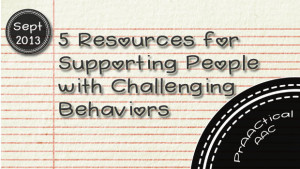
Need some help or new ideas for working with people who have challenging behaviors? Here are some resources to explore. 1. The Challenging Behavior Foundation is a UK-based organization with many good resources. You can check the archives of their newsletters here. 2. Wonderful instructional module on Functional Communication Teaching on the Autism Training Modules website. It takes time to work through this, but the information makes it worth the trouble. You may have to register (free) the first time you visit the site. 3.The National Professional Development Center on ASD has great information on Functional Communication Teaching, an approach with a strong evidence base. 4. The Functional Behavior Assessment Worksheet by PaTTAN 5. Our Pinterest board on Positive Behavior Support
Filed under: PrAACtical Thinking
Tagged With: Challenging Behavior, resources
September 18, 2013
by Robin Parker -
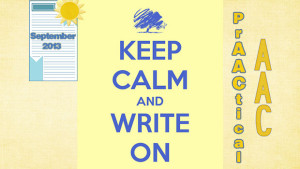
Just like reading, everyone needs opportunities to write. We write to make lists, give notes, tell stories, make signs, write letters, show love, vent, remember things, and much more. All students need lots of writing prAACtice and direct instruction. Here are some (just a few) amazing assistive technology options to help writers at all levels of the writing continuum. Picture Symbol Based Clicker Sentences- For emergent writers, students tap words in a grid to build sentences in a simple word processor. Pictures can be added to further increase comprehension of the sentences. Available as computer software with an evaluation option to try it out free for 30 days as well as in an iOS app Abilipad– A fully customizable keyboard and notepad, with word prediction and text-to-speech. This includes setting up a picture based key board. Check out the Abilipad website for more information about all of the possibilities. Kidspiration Maps– a visual way to mind... [Read More...]
Filed under: PrAACtical Thinking
Tagged With: literacy, resources, writing
September 17, 2013
by Robin Parker -

It’s International Literacy Month. We want to take this opportunity to remember that EVERYONE should have direct literacy instruction. Some students will be starting by learning to enjoy books while others will be readers already. Either way, there should be a literacy plan with short term and long term goals. If you need ideas for beginning or just expanding reading skills, here are some seriously excellent literacy resources for AAC. Take a look, enjoy and please let us know your favorite literacy resources so we can add them to this list. TalkSense- 101 ideas for literacy and AAC. Also, provides access to many picture symbols and litSymbols Jane Farrall’s Blog: Literacy, AAC, & Assistive Technology– Literacy resources specific to AAC and assistive technology Tar Heel Reader – books for beginning readers of all ages. Bookshare- accessible books and journals for readers with print disabilities Center for Literacy and Disabilities Studies–... [Read More...]
Filed under: PrAACtical Thinking
Tagged With: literacy, resources
September 12, 2013
by Robin Parker -
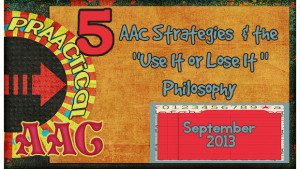
School has begun for almost everyone. Some classes have been in session for a while and routines have been formed, learning is taking place, behaviors have settled down. Now comes what can seem like the hard part: Keeping up with and expanding the strategies that helped students become successful. Instead of trying to fade AAC displays/devices and visual supports, stick with the basics and expand how they can be used. Because if you don’t use it, you may lose it. So: Keep up with: Visual Schedules– monthly, daily, and mini. Even if students know the schedule, continue to use it. Most of us would not like ‘losing’ our day planner or ‘to do’ lists even though we know our schedules. Aided Language Input First- Then Visual Support Visual Boundaries Access to a AAC Display/Device– And the display or device is with the student All the time, everywhere, charged, working, and... [Read More...]
Filed under: PrAACtical Thinking
Tagged With: aided language input, resources, visual schedules, visual supports
September 1, 2013
by Robin Parker -
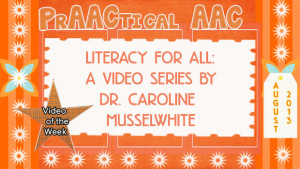
Dr. Caroline Musselwhite addresses the topic of overall good literacy instruction. She presents information about how to teach students with significant disabilities using fairly common literacy instruction strategies. There are 11 short video posts to help you get started. She discusses the issues of AAC and suggests strategies that are easy to implement and highly effective. Keep Calm and Watch On…
Filed under: Video of the Week
Tagged With: Instruction, literacy, resources
August 24, 2013
by Robin Parker -
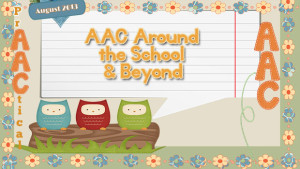
For the August Strategy of the Month, we have been thinking, writing, & talking about AAC in School. School is where AAC learners spend a large portion of their days. There needs to be multiple opportunities for students to USE and LEARN AAC each day. More than that though, we strive for full participation and interaction for students who use AAC. Students should not have to prove that they can do these things before they have ACCESS to AAC strategies and intervention. Here are some things that can be done to help build AAC participation for both students and educators. Provide ACCESS to AAC devices and visual supports throughout ALL activities in ALL places in school and on school sponsored trips/community based instruction. Provide Aided Language Input when teaching AAC to students. Use a Core Word approach when teaching AAC to students but don’t forget about Fringe Vocabulary. Learn and use partner assisted communication... [Read More...]
Filed under: Strategy of the Month
Tagged With: communication, inclusion, language, resources, strategies









